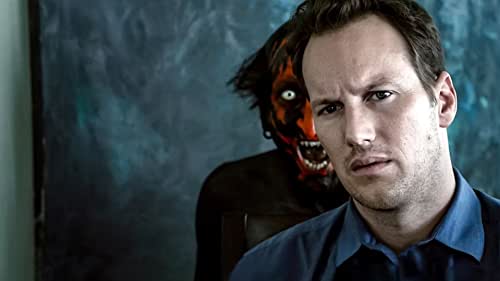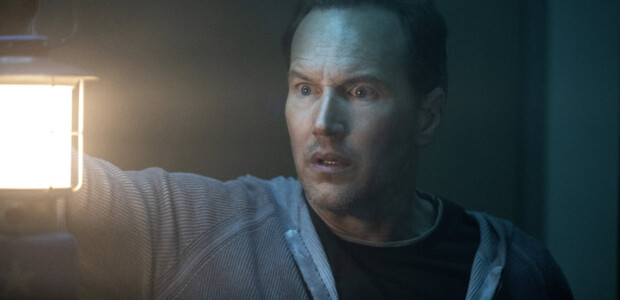Over the past twenty years, James Wan and Leigh Whannell have made careers out of zigging and zagging away from expectations. Whether they were definitively killing off Jigsaw in his third outing or taking big, oddball swings with the likes of DEAD SILENCE, you were never quite sure what these two might be up to, a trend that’s continued as the two have gone their separate ways. Never was this more apparent than it was in INSIDIOUS, the duo’s last creative collaboration to date. What started as an obvious POLTERGEIST homage sprawled into an epic tale of generational trauma spanning several decades as the besieged Lambert family faced its literal demons with the help of Elise (Lin Shaye), Tucker (Angus Sampson), and Specs (Whannell), the ghostbusting trio who subsequently took up the reigns in a pair of prequels. The quartet of films forms a horror franchise defined by its beloved protagonists: sure, the mysterious, crimson-faced “Lipstick Demon” might be its mascot, but along the way, Wan and Whannell shaped INSIDIOUS into a kooky Lin Shaye vehicle, giving a venerated 70-year-old character actress her time in the spotlight — a bold move by any standards, much less Hollywood standards that hardly allow such a thing to happen.
But with the last entry — 2018’s THE LAST KEY — closing the loop and setting up the events of the first film, it seemed inevitable that INSIDIOUS would return to the family that started it all. That inevitability lingers over THE RED DOOR, the most conventional entry in the franchise so far. Despite being the first actual sequel in a decade, it’s a return to familiar territory and familiar faces going through the expected motions, an approach that has its obvious appeal in a landscape dominated by nostalgia-tinged legacy sequels. But in a franchise that’s often resisted taking the obvious route, THE RED DOOR feels like a capitulation to formula, albeit a winning one that still yields a solid follow-up as star Patrick Wilson assumes the director’s chair.

Nine years after Josh and Dalton Lambert (Patrick Wilson & Ty Simpkins) endured — and were hypnotized into forgetting—their trip into The Further, the father and son have become estranged. In recent years, Josh has been at a distance from the family following a divorce from Renais (Rose Byrne), citing a weird brain fog that’s made it difficult for him to be present. The loss of his mother (Barbara Hershey) doesn’t help matters, especially when Josh bumps into Carl (Steve Coulter), Elise’s long-time associate and the man responsible for wiping his mind years ago. While Josh doesn’t immediately recognize him, the encounter cracks open a door for the demons lurking in The Further, who start to encroach once again. Likewise, Dalton’s move to college only uncovers ghosts from his past when his art teacher’s (Hiam Abbass) unconventional methods unlock his repressed memories, putting him and his roommate Chris (Sinclair Daniel) in grave danger.
THE RED DOOR is like a good band reuniting without a few key members: they may be able to scratch out a few bangers that make the whole endeavor worthwhile, but you also can’t shake the feeling that something’s missing. It’s unmistakably an INSIDIOUS film and all of the spook-a-blasting that entails, meaning there’s no shortage of jumps, jolts, and composer Joseph Bishara going to town on his strings section. You get exactly what you expect from INSIDIOUS 5, which might be part of the problem: it all feels a little too familiar, almost like that same band trying to recapture its greatest hits instead of forging a new, exciting sound, something the previous sequels excelled at. They didn’t just give you what you wanted: they gave you something you didn’t know you needed, like time-travel wrinkles and deep dives into the characters’ lore. THE RED DOOR attempts to do the latter by delving into the unexplored history of Josh’s absent father, widening the scope of the franchise and giving this entry a thematic throughline of fathers reconnecting with sons. It works well enough and keeps the film from simply being a parade of scares, but it’s also slightly strained and tacked on. It also only accentuates the absence of Barbara Hershey, one of the more underappreciated pieces of the INSIDIOUS puzzle that’s sorely missing this time out.
Remarkably, the relative absence of Wan and Whannell — both of whom serve as executive producers, with the latter also carrying a story credit — don’t constitute the biggest missing pieces here. It helps that Wilson was clearly taking notes from the duo, particularly when it comes to crafting scares. THE RED DOOR boasts three exquisitely orchestrated sequences, including one that makes clever use of tiles on a window to build a creeping dread that leaves you bracing for a jolt that’s somehow even more jarring than expected. (The MRI sequence prominently highlighted by the marketing is good too, but you already know that, since one of the trailers nearly features the entire scene.) INSIDIOUS was one of the pivotal films that contributed to the genre’s shift towards haunted house thrill rides, and its edge hasn’t dulled during the past 13 years — it’s still as unnerving as ever, and this one arguably boasts the most genuine, suffocating dread. During a mostly scare-free opening stretch that mostly involves Josh helping Dalton move on campus, the tension between the estranged father and son dovetails with the creeping realization that their demons haven’t been vanquished, giving the film a nervous, coiled energy that unspools over the last hour.

It’s that unspooling that reveals the film’s most crucial missing pieces, a trio of elephants who are largely not in the room: Elise, Tucker, and Specs, the sweet, beloved found family responsible for giving the series its idiosyncratic sense of humor and purpose. This trio provided levity and heart in equal measure, and the playful exchanges between Sampson and Whannell were especially fun. It was this interplay and characters that helped the original film beat the POLTERGEIST rip-off accusations: Shaye wasn’t just doing a Zelda Rubenstein routine, and her two co-stars forged personalities of their own. To its credit, THE RED DOOR acknowledges their importance by giving them all cameos; however, these brief appearances only emphasize just how much the rest of the film misses them.
This film isn’t completely humorless because of their absence, as Sinclair Daniel shoulders the comic relief as Chris, a girl whose traditionally masculine name causes a mix-up that results in her becoming Dalton’s roommate for a night. She embraces the task with aplomb, handling Scott Teem’s snappy dialogue with a confidence that keeps Chris from feeling too affected. Her rapport with Simpkins is an unexpected delight, and the duo’s campus hijinx — which finds them investigating a haunted frat house currently lorded over by an obnoxious bro named Nick the Dick (Peter Dager) — evokes the colorful characters and scenarios from previous films. It’s just that they don’t quite measure up to them — at this point, there’s simply no replacing the Spectral Sightings clue, so it’s a shame they couldn’t make THE RED DOOR a more proper reunion.
That leaves the Lambert clan to pick up the slack, and they do it well enough. Like her old co-stars, Byrne only appears for some crucial scenes, meaning this is largely Simpkins and Wilson’s show as they take turns being haunted separately before reuniting once again in The Further, where we refreshingly come no closer to figuring out what the Lipstick Demon’s deal is. He’s still ruling over this nightmarish dreamscape, once again holding Dalton prisoner during a deja vu climax that has fun with the franchise’s propensity for time-twisting. Instead of finally revealing any long-held secrets in The Further, Wilson doubles down on the familial drama, making it clear that he’s invested more in fathers reconciling with sons than he is in exploring any franchise mythology. The titular red door becomes an obvious metaphor for dealing with, yes, grief and trauma, the twin pillars of recent horror fare. It’s not ill-fit, especially since this franchise has dwelled here for the past two movies anyway, and it allows THE RED DOOR to embrace the franchise’s signature sentimentality.
While this outing might need a little bit more blast in the spook-a-blast formula, it totally wears its heart on its sleeve when it comes to its characters. Wilson’s love of his fictional family is evident, so it’s no surprise that the film’s two most effective scenes — one during the climax, one during the denouement—are emotionally charged, human moments that remind us what drew us to this franchise in the first place. Sure, a nightmarish hellscape crawling with demons and unrested souls is great, but have you seen Patrick Wilson — one of our great avatars of male vulnerability — spill his entire heart and soul on the screen? There’s so much sentiment in THE RED DOOR that it even spills over into the end credits, where Wilson provides the vocals on Ghost’s rendition of Shakespears Sister’s “Stay,” a decision that was inspired by Dokken’s “Dream Warriors.” I can only salute such a bold vision, and can only hope that Wilson has more opportunities to let his nerdy, emo flag fly, whether it’s in The Further or beyond.
Tags: Andrew Astor, Angus Sampson, Autumn Eakin, Barbara Hershey, Blumhouse Productions, Derek Ambrosi, Ghost, Hiam Abbass, Horror, James Wan, Jason Blum, Joseph Bishara, Leigh Whannell, Lin Shaye, Patrick Wilson, Rose Byrne, Scott Teems, Sequels, Sinclair Daniel, Steve Coulter, Ty Simpkins



No Comments